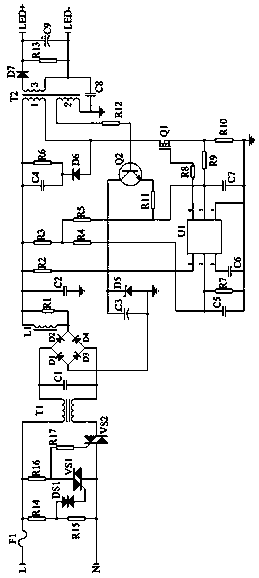LED driving energy-saving power source with function of overvoltage protection
A LED drive and overvoltage protection technology, applied in the direction of electric light source, electroluminescent light source, light source, etc., can solve the problems of reducing maintenance cost, LED drive power cannot be self-recovery, etc., to achieve the effect of reducing maintenance cost and enhancing utilization rate
- Summary
- Abstract
- Description
- Claims
- Application Information
AI Technical Summary
Problems solved by technology
Method used
Image
Examples
specific Embodiment 1
[0024] see figure 1 As shown, the present invention is an LED-driven energy-saving power supply with overvoltage protection, including: mains input circuit, overvoltage protection circuit, rectifier bridge, drive chip U1, power switch tube Q1, NPN transistor Q2, switching transformer T2 and the power supply output terminal; the mains input circuit is connected to the driver chip U1 through the overvoltage protection circuit and the rectifier bridge in turn; the driver chip U1 is connected to the power supply output terminal through the power switch tube Q1 and the switching transformer T2 in turn; the driver chip U1 is connected to the power supply output terminal through the NPN Transistor Q2 is connected to switching transformer T2; overvoltage protection circuit includes resistors R14, R15, R16, R17, trigger tube DS1 and bidirectional thyristor VS1, VS2; resistor R14 is connected in series with resistor R15, resistor R16 and resistor R17 are connected in series Connected i...
specific Embodiment 2
[0033] When the power switch tube Q1 is turned off, when the induction current of the switching transformer T2 coil 2 becomes small, the function of the NPN transistor Q2 is the function of the transistor itself, and the voltage in the filter capacitor C3 can be controlled with a small Ib current to pass through the NPN transistor Q2 Send the zero current detection signal to pin 5 of the driver chip U1. The voltage value of the zero-current detection signal on pin 5 of the driver chip U1 is 0.35V, that is, when the voltage of the zero-current detection signal is greater than 0.35V, the power switch tube Q1 is turned off, and the induced voltage of the switching transformer T2 coil 3 can continue to be sent to the load . Once the voltage of the zero-current detection signal is equal to 0.35V, the power switch tube Q1 will be turned on again, and the coil 3 of the switching transformer T2 will immediately terminate the power supply to the load.
specific Embodiment 3
[0034] The overvoltage protection self-recovery circuit is composed of resistors R14, R15, R16, R17, trigger tube DS1 and bidirectional thyristor VS1, VS2. When the input mains voltage is normal, the resistors R16 and R17 supply the gate voltage of the bidirectional thyristor VS2, the bidirectional thyristor VS2 is normally turned on, and the mains voltage is supplied to the driving circuit behind through the bidirectional thyristor VS2, the whole circuit normal work. The voltage divided by the resistors R14 and R15 is not enough to turn on the trigger tube DS1, the trigger tube DS1 is in the off state, the triac VS1 is also in the off state, and has no effect on the triac VS2. When the input mains voltage is too high and reaches 280V, the voltage obtained by dividing the resistor R14 and resistor R15 will turn on the trigger tube DS1, and the trigger tube DS1 will be turned on to supply the gate voltage of the bidirectional thyristor VS1. SCR VS1 is turned on. After the bid...
PUM
 Login to View More
Login to View More Abstract
Description
Claims
Application Information
 Login to View More
Login to View More - R&D
- Intellectual Property
- Life Sciences
- Materials
- Tech Scout
- Unparalleled Data Quality
- Higher Quality Content
- 60% Fewer Hallucinations
Browse by: Latest US Patents, China's latest patents, Technical Efficacy Thesaurus, Application Domain, Technology Topic, Popular Technical Reports.
© 2025 PatSnap. All rights reserved.Legal|Privacy policy|Modern Slavery Act Transparency Statement|Sitemap|About US| Contact US: help@patsnap.com


